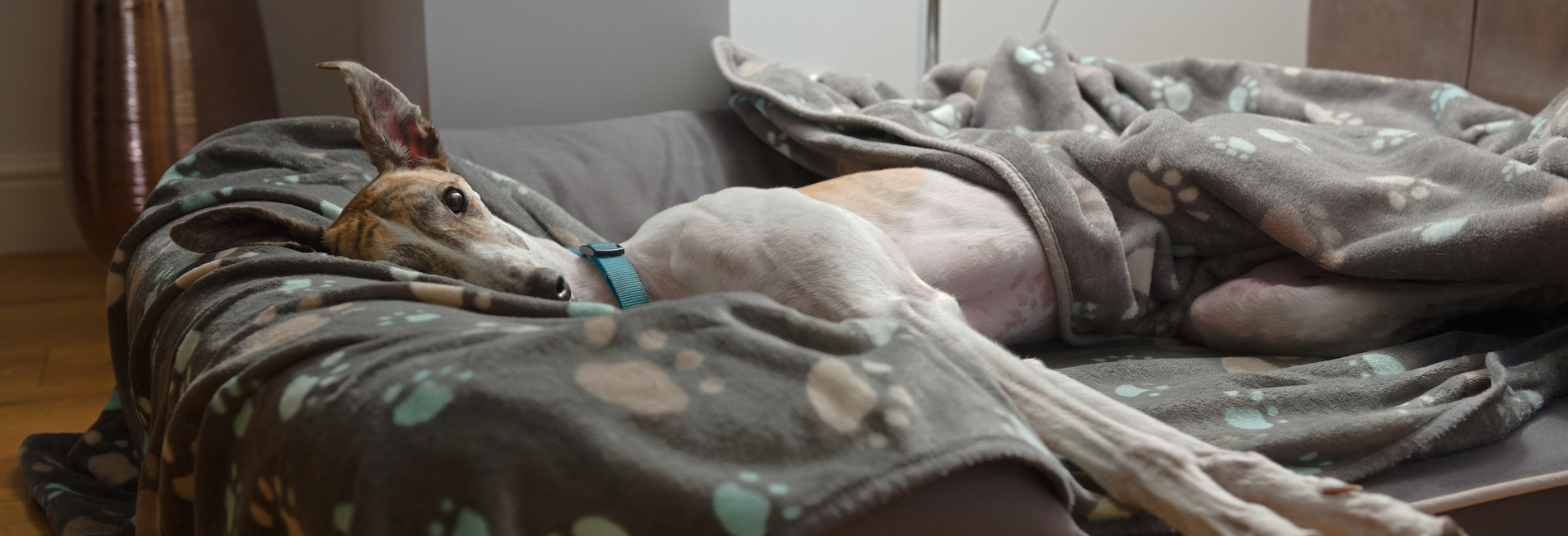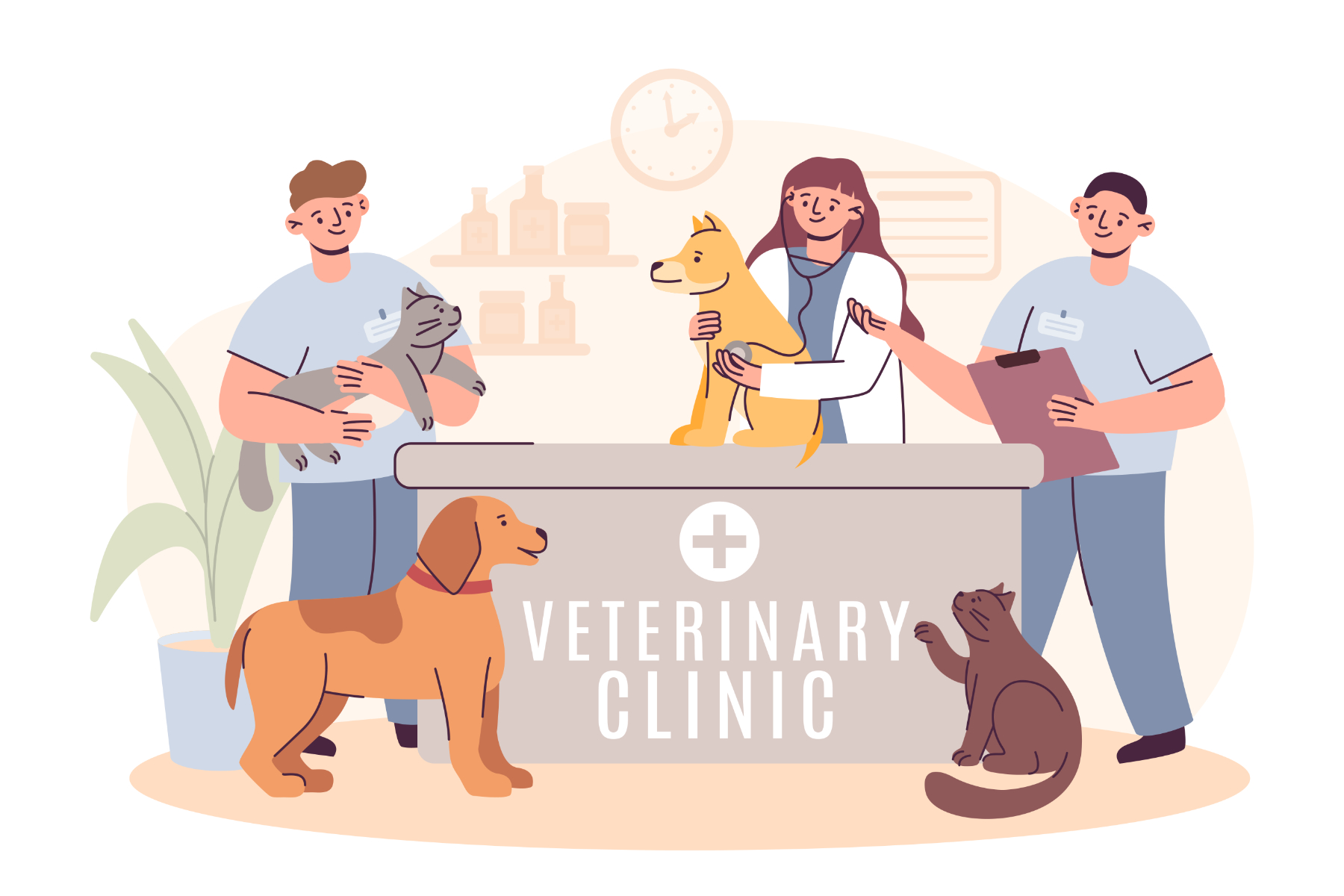Greyhounds are a member of the ‘Hound’ breed group. The Hound group includes breeds originally used for hunting either by scent or sight. The Greyhound is a sighthound, intelligent in nature, gentle - and despite their great athletic ability, is happy to spend most of the day sleeping. Built for speed, the Greyhound has a streamlined body, with a long neck. Their ears, when relaxed, are folded flat against the neck, but will face forward and stand upward when at attention. A Greyhounds coat is short and smooth, being easy to maintain. With virtually no body fat on a Greyhound, it is important to provide soft places for them to rest.
History of Greyhounds
The Greyhound is one of the oldest breeds in history. They can be traced back over 4,000 years to early cave drawings and are the only breed mentioned in the Bible. There are a number of different explanations for the origin of the name Greyhound. From the suggestion that the original Greyhound was gray in colour, to the name being from the Old English “grei”, meaning dog and “hundr”, meaning hunter. Throughout history, the Greyhound has been depicted as a noble dog in art and literature, and the breed has long been associated with royalty.
For thousands of years, Greyhounds were bred to hunt by outrunning their prey. A Greyhound can reach a speed of over 40 miles per hour, making them the fastest breed of dog. Over time, careful breeding and handling have made the Greyhound an intelligent and affectionate companion. Track racing is common today for the Greyhound, and the racing type of Greyhound has become the most populous. As a result of this, in more recent years an effort has been made to find homes for retired racing Greyhounds, which has led to an increased awareness of the potential a Greyhound has a wonderful pet.
Quick Facts About Greyhounds
Group: Hound
Size: Large
Height: Male 71-76cm, Female - 69-71cm.
Weight: Male - 27-40kg, Female - 26-34kg.
Average Retirement Age: Between 3-5 years of age.
Average Lifespan: Up to 15 years.
Moulting Level: Medium.
Grooming: Light.
Exercise Required: Two twenty minute walks a day.
Temperament: Intelligent, gentle, affectionate, even tempered.
General: Greyhounds get along with children, the elderly and people with disabilities, and can live happily with pets including cats.
Getting your Dog
How to Adopt a Greyhound
Greyhounds make great pets and are suitable for all types of families. This includes whether you work, have children, or have other pets. Greyhounds can be matched to all types of individual situation.
The Greyhound Trust operates a network of over 50 volunteer-led branches across Britain. Locate one close to you and arrange a visit to see if there is a Greyhound available which you can re-home and make your new companion.
Most Greyhounds will tend to retire from racing between three and five years of age, meaning they are relatively young dogs who have a long life ahead of them.
Greyhounds are retired and re-homed by charities for a number of reasons. This can include a lack of prey drive whereby they do not chase and run, injury caused either on or off the track, them not being fast enough to win races, or a general lack of interest in racing.
Caring for a Greyhound
Greyhounds are low-maintenance, gentle, laid-back dogs that do not require a lot of exercise. A Greyhound will happily spend their retirement days sleeping quietly of a nice, soft bed!
Racing Greyhounds are bred for their fitness, as opposed to any physical characteristics. A Greyhound will tend to have a fairly predictable and structured life as a racing Greyhound. This will include allotted feeding times, grooming, exercise, and racing. This means that prior to retirement, a Greyhound will not have experienced the sounds and activities of a home environment.
Settling a Retired Greyhound into your Home
Remember that when you introduce your Greyhound to your home, everything they are experiencing will be new to them. Therefore, they should be introduced to all the experiences in a slow and calm manner. A good example is stairs, which your Greyhound ay not have had to conquer before. We have been known to crawl up and down the stairs as an act of demonstration for our Greyhound copy, which generally works - provided you are patient and give your Greyhound time to adapt.
When your Greyhound arrives at your home, take them into the garden and start to establish a going to the toilet routine. When you are in the garden for the first few days, keep your Greyhound on a lead or supervised. If your garden happens to have a cat in it, whether yours or a cat from another home, keep your Greyhound in a muzzle for the first few weeks to ensure no nasty accidents occur. A neighbours cat will soon learn to avoid your garden, once a Greyhound is introduced to the equation!
Do they need much exercise?
Your Greyhound is built for sprinting as opposed to endurance. As a result, a Greyhound makes the perfect companion for any type of walk. Greyhounds have a lack of body fat, so you are best providing them with a coat for walking in colder temperatures. As a general rule, any temperature which requires you to wear a jacket, should result in you putting a jacket on your Greyhound too. Think of their coats as being like a t-shirt for yourself, if you feel chilly in just a t-shirt, it is likely your Greyhound will feel them same!
When racing, a Greyhound will very rarely meet other dog breeds. Therefore, it may take a while to adjust to meeting different types of dogs, when they are out on walks. In practice, just be cautious, especially at first. Keep your Greyhound on a short lead when you approach other dogs and you will quickly learn their reactions. Be wary letting your Greyhound off-lead, until you are sure you can recall them easily.
Feeding Your Greyhound
Greyhounds are typically fed a very high protein diet when they race, which helps to strengthen and develop their muscles. Your homed Greyhound will not require this type of food going forward. If you are keen to keep costs down, then there are Greyhound formulated dry foods available, or any dog food available from your local pet shop would be suitable.
As a tall breed, it is a good idea to provide your Greyhound with raised bowls, which will reduce the strain on their necks.
Grooming
Greyhounds are low maintenance, however you will still need to wash and groom them. General grooming and bathing will help to keep your Greyhound healthy and happy.
- Baths and showers tend to be the best place to bathe your Greyhound. Put a mat down to stop them from slipping over.
- Greyhound’s can be sensitive to shampoos with a lot of chemicals or scents. Ensure you use a gentle shampoo with simple ingredients to avoid this.
- Use a face cloth or hand towel to gently wash your Greyhounds face.
- Have a grooming brush or mitt to help remove any excess hair from your Greyhound.
- Clip the nails with a nail clipper, or alternatively use a Dremel intended for dogs, to keep the nails at a short length. As a general rule, when your Greyhound is stood, you should be able to easily slide a piece of paper between the end of the nail and the floor.
- If you get back from a muddy walk, or your Greyhound has just had a run in the garden following some rainfall, have a towel to hand to wipe the feet.
Health
The potential health problems that Greyhounds are prone to include:
- Gastric Dilation Volvulus (GDV) - often known as ‘bloat’, this is a condition where the stomach twists, trapping the contents and gases. This is an emergency and requires urgent veterinary attention.
- Periodontal disease - infection and inflammation of the tissues that surround and support the teeth.
- Progressive retinal atrophy - gradual deterioration of the retina of the eye. Symptoms can start with night blindness and progress to total blindness.
- Osteosarcoma - bone cancer.
- Von Willebrand’s disease - deficiency in blood platelet function resulting in excessive bleeding.
- Hyperthermia and rigid paralysis can sometimes occur following exercise.
Ownership costs
The likely lifetime cost for a Greyhound will need to be considered, and will typically include the following:
The list above does not include veterinary costs if your pet becomes sick or injured, so these average lifetime costs could be even higher.
Do they bark a lot?
Just like most dog breeds, Greyhounds do bark and for a variety of different reasons. Without plenty of physical stimulation and social interaction, Greyhounds will bark more than normal, possibly to excess, due to their pent-up energy.
If you find that your Greyhound is still barking even with plenty of stimulation, it could be because they’re scared, frustrated, guarding or even suffering from separation anxiety.
Can they be left alone?
Like most dogs, Greyhounds can be prone to separation anxiety which can manifest itself in a number of ways; from vocalisations (howling and/or barking) as soon as you leave the room, to destructive behaviour, or even toileting. Thankfully with training, most dogs can overcome separation anxiety and be trained to be left alone (more information on treating seperation anxiety in dogs can be found here).
As a general rule, Greyhounds should not be left alone for more than 8 hours but ideally you should limit your time apart from them to no more than 3-4 hours. Alternatives such as boarding or hiring a dog walker should be considered if that isn’t possible for your situation.
In recent years the number of Doggy Daycare providers have expanded rapidly. Whilst this can be relatively expensive, it does have the advantage of both socialising your dog with the other dogs there, and as well as providing peace of mind that your dog is being supervised for the entire day. However, if Doggy Daycare is out of your price range there are other options, such as using a dog walking service. Services such as Rover or Wag! offer skilled walkers at affordable prices. This option is appropriate when you know you’ll be gone longer than four hours. In turn, your dog will have a chance to go to the bathroom and exercise while you’re away.
Investing in a mentally stimulating toy is a great way to keep your Greyhounds separation anxiety at bay. Toys such as the ‘kong’ stuffed with food, are excellent at distracting your dog for the first 20-30 minutes when you leave.




